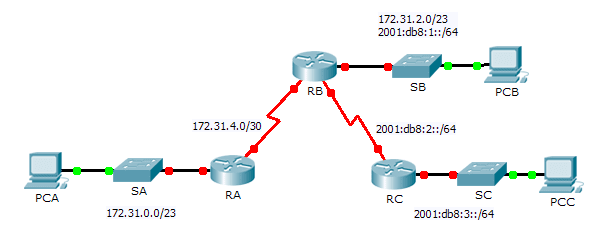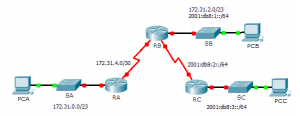Last Updated on April 24, 2018 by Admin
8.4.1.2 Packet Tracer – Skills Integration Challenge
From year to year, Cisco has updated many versions with difference questions. The latest version is version 6.0 in 2018. What is your version? It depends on your instructor creating your class. We recommend you to go thought all version if you are not clear. While you take online test with netacad.com, You may get random questions from all version. Each version have 1 to 10 different questions or more. After you review all questions, You should practice with our online test system by go to "Online Test" link below.
| Version 5.02 | Version 5.03 | Version 6.0 | Online Assessment |
| Chapter 8 Exam | Chapter 8 Exam | Chapter 8 Exam | Online Test |
| Next Chapter | |||
| Chapter 9 Exam | Chapter 9 Exam | Chapter 9 Exam | Online Test |
| Lab Activities | |||
| 8.2.2.7 Packet Tracer – Configuring OSPFv2 in a Single Area | |||
| 8.3.3.5 Packet Tracer – Configuring Basic OSPFv3 in a Single Area | |||
| 8.4.1.2 Packet Tracer – Skills Integration Challenge | |||
Packet Tracer – Skills Integration Challenge (Answer Version)
Answer Note: Red font color or gray highlights indicate text that appears in the Answer copy only.
Topology

8.4.1.2 Packet Tracer – Skills Integration Challenge
Addressing Table
| Device | Interface | IPv4 Address | Subnet Mask | Default Gateway |
| IPv6 Address/Prefix | ||||
| RA | G0/0 | 172.31.0.1 | 255.255.254.0 | N/A |
| S0/0/0 | 172.31.4.1 | 255.255.255.252 | N/A | |
| RB | G0/0 | 172.31.2.1 | 255.255.254.0 | N/A |
| 2001:DB8:1::1/64 | N/A | |||
| S0/0/0 | 172.31.4.2 | 255.255.255.252 | N/A | |
| S0/0/1 | 2001:DB8:2::1/64 | N/A | ||
| RC | G0/0 | 2001:DB8:3::1/64 | N/A | |
| S0/0/0 | 2001:DB8:2::2/64 | N/A | ||
| PC-A | NIC | 172.31.1.254 | 255.255.254.0 | 172.31.0.1 |
| PC-B | NIC | 172.31.3.254 | 255.255.254.0 | 172.31.2.1 |
| 2001:DB8:1::2/64 | FE80::1 | |||
| PC-C | NIC | 2001:DB8:3::2/64 | FE80::3 | |
Background
In this Skills Integration Challenge, your focus is OSPFv2 and OSPFv3 configurations. You will configure IP addressing for all devices. Then you will configure OSPFv2 routing for the IPv4 portion of the network and OSPFv3 routing for the IPv6 portion of the network. One router will be configured with both IPv4 and IPv6 configurations. Finally, you will verify your configurations and test connectivity between end devices.
Note: This activity is graded using a combination of assessment items and connectivity tests. The instructions window will not show your score. To see your score, click Check Results > Assessment Items. To see the results of a specific connectivity test, click Check Results > Connectivity Tests.
Requirements
- Use the following requirements to configure RA addressing and OSPFv2 routing:
- IPv4 addressing according to the Addressing Table
- Process ID 1
- Router ID 1.1.1.1
- Network address for each interface
- LAN interface set to passive (do not use the default keyword)
- Use the following requirements to configure RB addressing, OSPFv2 routing and OSPFv3 routing:
- IPv4 and IPv6 addressing according to the Addressing Table
- Set the Gigabit Ethernet 0/0 Link Local address to FE80::1
- OSPFv2 routing requirements:
- Process ID 1
- Router ID 2.2.2.2
- Network address for each interface
- LAN interface set to passive (do not use the default keyword)
- OSPFv3 routing requirements:
- Enable IPv6 routing
- Process ID 1
- Router ID 2.2.2.2
- Enable OSPFv3 on each interface
- IPv4 and IPv6 addressing according to the Addressing Table
- Use the following requirements to configure RC addressing and OSPFv3 routing:
- IPv6 addressing according to the Addressing Table
- Set the Gigabit Ethernet 0/0 Link Local address to FE80::3
- OSPFv3 routing requirements:
- Enable IPv6 routing
- Process ID 1
- Router ID 3.3.3.3
- Enable OSPFv3 on each interface
- IPv6 addressing according to the Addressing Table
- Configure PCs with appropriate addressing.
- PCA and PCB IPv4 addressing must use the last assignable address in the IPv4 subnet.
- PCB and PCC IPv6 addressing must use the second assignable address in the IPv6 network and the link-local FE80 address as the default gateway.
- Finish the Addressing Table documentation
- Verify your configurations and test connectivity
- OSPF neighbors should be established and routing tables should be complete
- Pings between PCA and PCB should be successful
- Pings between PCB and PCC should be successful
Note: If OSPFv3 has not converged, check the status of interfaces using the show ip ospf interface command. Sometimes, the OSPFv3 process needs to deleted from the configuration and reapplied to force convergence.
!—————————-
!RA
!—————————-
ena
config t
hostname RA
interface GigabitEthernet0/0
ip address 172.31.0.1 255.255.254.0
no shut
interface Serial0/0/0
ip address 172.31.4.1 255.255.255.252
no shut
router ospf 1
router-id 1.1.1.1
passive-interface GigabitEthernet0/0
network 172.31.0.0 0.0.1.255 area 0
network 172.31.4.0 0.0.0.3 area 0
end
!---------------------------- !RB !---------------------------- ena conf t hostname RB ipv6 unicast-routing interface GigabitEthernet0/0 ip address 172.31.2.1 255.255.254.0 ipv6 address 2001:DB8:1::1/64 ipv6 address FE80::1 link-local ipv6 ospf 1 area 0 no shut interface Serial0/0/1 no ip address ipv6 address 2001:DB8:2::1/64 ipv6 ospf 1 area 0 no shut interface Serial0/0/0 ip address 172.31.4.2 255.255.255.252 no shut router ospf 1 router-id 2.2.2.2 passive-interface GigabitEthernet0/0 network 172.31.2.0 0.0.1.255 area 0 network 172.31.4.0 0.0.0.3 area 0 ipv6 router ospf 1 router-id 2.2.2.2 end clear ipv6 ospf process y ! !NOTE: If OSPFv3 does not converge, enter the following: int g0/0 no ipv6 ospf 1 area 0 ipv6 ospf 1 area 0
!---------------------------- !RC !---------------------------- ena conf t hostname RC ipv6 unicast-routing interface GigabitEthernet0/0 ipv6 address 2001:DB8:3::1/64 ipv6 address FE80::3 link-local ipv6 ospf 1 area 0 no shut interface Serial0/0/0 no ip address ipv6 address 2001:DB8:2::2/64 ipv6 ospf 1 area 0 no shut ipv6 router ospf 1 router-id 3.3.3.3 end clear ipv6 ospf process y !
From year to year, Cisco has updated many versions with difference questions. The latest version is version 6.0 in 2018. What is your version? It depends on your instructor creating your class. We recommend you to go thought all version if you are not clear. While you take online test with netacad.com, You may get random questions from all version. Each version have 1 to 10 different questions or more. After you review all questions, You should practice with our online test system by go to "Online Test" link below.
| Version 5.02 | Version 5.03 | Version 6.0 | Online Assessment |
| Chapter 8 Exam | Chapter 8 Exam | Chapter 8 Exam | Online Test |
| Next Chapter | |||
| Chapter 9 Exam | Chapter 9 Exam | Chapter 9 Exam | Online Test |
| Lab Activities | |||
| 8.2.2.7 Packet Tracer – Configuring OSPFv2 in a Single Area | |||
| 8.3.3.5 Packet Tracer – Configuring Basic OSPFv3 in a Single Area | |||
| 8.4.1.2 Packet Tracer – Skills Integration Challenge | |||
